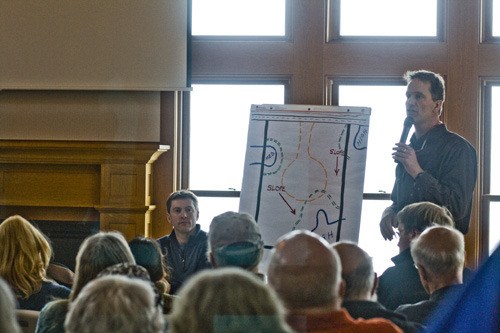Under the stained glass window of the church, a lawyer presented a slide show with the words “the land speaks first.”
It was one of the last slides in a series of presentations where local experts spoke about the update of the county’s critical areas ordinance, Feb. 29 at Emmanuel Episcopal Church. The forum was sponsored by Friends of the San Juans.
“I’m reviewing the code and drafting comments and I have some strong issues with some points,” said Scott Rozenbaum, a certified wetland and soil scientist. “If you have issues pro or con I urge you to draft them up too.”
The county’s critical areas are environmentally sensitive natural resources that have been designated for protection and management in accordance with the requirements of the state Growth Management Act. While the county’s first CAO was adopted in 1991, newer laws require regulations to consider the habitats of peregrine falcons, marbled murrelets, southern resident orca, and chinook salmon, and updated mapping. The regulations will apply to all activities considered “development,” not just those needing a permit. The update is more than six years overdue.
As required by law, San Juan County is taking into consideration “Best Available Science” using a synthesis of 1,900 scientific documents.
The county has been criticized as being extreme, radical, not providing clear planning rules and basic permitting at affordable fees, and valuing the environment over individual property rights.
At the recent meeting, presenters included Rozenbaum, Kyle Loring, attorney for the Friends of the San Juans, Agricultural Resources Committee Coordinator Peggy Bill and County Planner Janice Biletnikoff.
More than 125 islanders filled seats and lined the walls of the church to ask questions and hear panelists discuss how and why the CAO is being updated. The presenters focused their talks on the wetland portion of the CAO.
“The county has been regulating wetlands for the last 20 years,” said Rozenbaum, who discussed some of the changes coming up for review in the updated draft of the CAO.
Current ordinances require a buffer of 35 to 200 feet, new proposals seek to widen certain buffers to 260 feet.
There will be provisions for wetlands in urban growth areas from 30 to 115 feet buffers.
In the current CAO, property owners could have one side of the wetland buffer shortened as long as another side was widened to compensate – that will not be allowed in the updated draft of the CAO.
The wetland ratings are also changing. Wetlands will be rated by their importance and sensitivity, rather than being evaluated on their shape or rarity.
Instead of having blanket regulations for wetland buffers, the county’s goal is to have cases tailored to specific sites, said Biletnikoff.
CAO mitigation, which could include planting vegetation or deer fences, will mirror state and federal regulations, instead of having separate county regulations.
In the current CAO land needed to be a minimum of 1 acre to adhere to regulations – there is no longer a minimum.
Rozenbaum said if property owners are concerned that they have a wetland on their property, it is up to them to prove or disprove it. There are two options for further investigations.
A reconnaissance assessment by a scientist lasts only a few hours and could cost only few hundred dollars, but a more involved detailed report could cost up to $5,000, according to Rozenbaum.
And if there is a wetland, mitigation, which could include planting vegetation or removing a structure, may be required. Rozenbaum said there is no list of county approved scientists to do these reports.
For property owners building on land with wetlands Rozenbaum said, “The architect, landowners and scientist work together on wetland buffers.”
Peggy Bill discussed protecting viable agriculture and the CAO, and looking at how to encourage and promote existing and ongoing agriculture. She said that the county should opt-in the Volunteer Stewardship Program, which would provide more local control.
She said 80 percent of farmers have wetlands on their properties and have been farming on them for centuries on mostly low sensitivity wetlands, referring to the CAO’s new rating.
“Can agriculture continue if we can’t farm in wetlands?” Bill asked. “No.”
Questions
At the end of the two hour meeting, there were 18 questions and only 20 minutes to answer.
One islander asked how existing roadways with stormwater runoff would be dealt with.
“The county is held to the same standards as home owner,” said Rozenbaum. “They have to deal with impacts direct and indirect and how to have better stormwater quality and mechanisms.”
Other questions included what are buffer zone regulations in other counties, and what kind of regulations must be followed for a frog farm?
Biletnikoff said that other counties have similar buffer zones, but that each county is unique and comparing them is like comparing apples and oranges.
As for frog farms or any other commercial farming endeavor the individual would have to follow the CAO rules – including getting your property reviewed by a scientist and possible mitigation.
The County Planning Commission Review for the latest draft of the wetlands portion of the CAO is on March 6.
For more info, visit sanjuanco.com/cao/.



